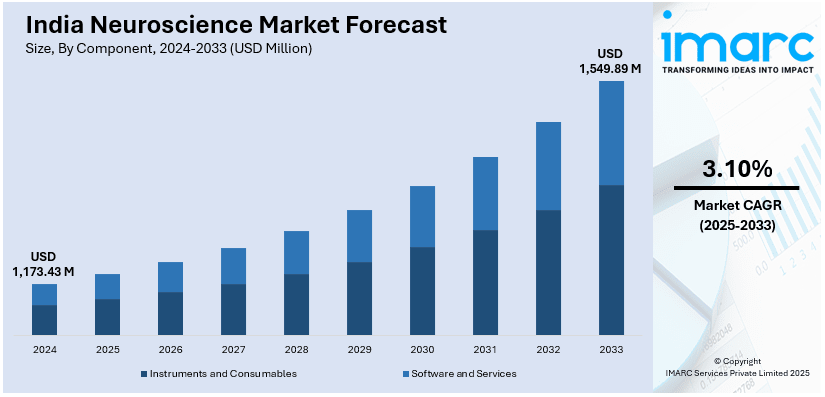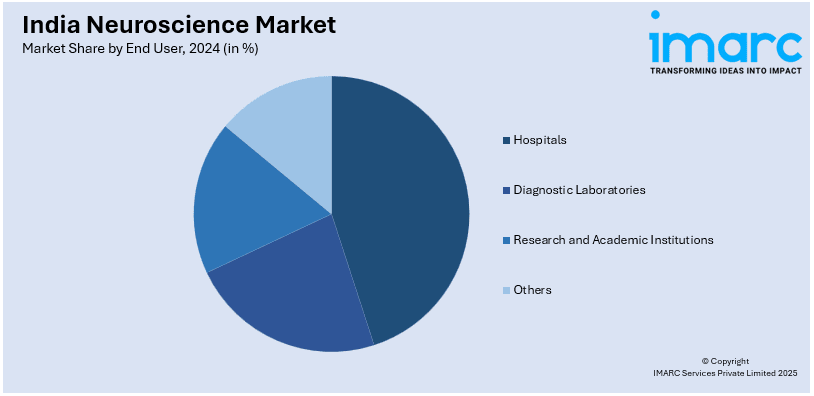
India Neuroscience Market Size, Share, Trends and Forecast by Component, Technology, End User, and Region, 2025-2033
India Neuroscience Market Overview:
The India neuroscience market size reached USD 1,173.43 Million in 2024. Looking forward, IMARC Group expects the market to reach USD 1,549.89 Million by 2033, exhibiting a growth rate (CAGR) of 3.10% during 2025-2033. The market is expanding due to advancements in brain imaging, AI-driven diagnostics and increasing research in neurodegenerative diseases. Growing investments in brain-computer interfaces, neuromodulation and precision medicine are also contributing positively to the market growth across the country.
|
Report Attribute
|
Key Statistics
|
|---|---|
|
Base Year
|
2024 |
|
Forecast Years
|
2025-2033
|
|
Historical Years
|
2019-2024
|
| Market Size in 2024 | USD 1,173.43 Million |
| Market Forecast in 2033 | USD 1,549.89 Million |
| Market Growth Rate 2025-2033 | 3.10% |
India Neuroscience Market Trends:
Rising Focus on AI and Machine Learning in Neuroscience
AI and machine learning are revolutionizing neuroscience by enhancing brain mapping, diagnostics and predictive analytics. These technologies enable faster and more accurate analysis of neurological disorders contributing to India neuroscience market growth as healthcare providers adopt AI-driven tools for early detection and personalized treatment planning. AI-powered algorithms improve neuroimaging interpretation, automate EEG and MRI analysis and assist in diagnosing conditions like Alzheimer’s, epilepsy and stroke with higher precision. For instance, in January 2024, Siemens Healthineers and IISc launched a Collaborative Laboratory for AI in Precision Medicine. The lab will focus on developing open-source AI tools for neuroimaging enhancing the diagnosis of neurological diseases. It aims to integrate AI into clinical workflows and promote female representation in AI through MTech fellowships. Machine learning models are also advancing brain-computer interface (BCI) applications enabling communication for patients with paralysis. Additionally, AI-driven drug discovery accelerates the development of targeted neurological treatments. Hospitals and research institutions are increasingly leveraging AI for real time patient monitoring and predictive analytics improving treatment outcomes. With ongoing advancements and greater adoption across clinical and research settings AI and machine learning are set to play a crucial role in shaping India neuroscience market share.

To get more information on this market, Request Sample
Growing Investments in Brain-Computer Interfaces (BCIs)
Brain-Computer Interfaces (BCIs) are gaining traction in India with increasing investments driving advancements in assistive technology, cognitive research and neurorehabilitation. For instance, in November 2024, Nexstem a Bengaluru-based deep-tech startup raised $3.5 million to enhance its brain-computer interface (BCI) technology aiming to democratize neurotech solutions across various sectors. The funding backed by notable investors will support product scaling, global expansion and innovative applications targeting markets in the US and Europe. BCIs enable direct communication between the brain and external devices assisting patients with paralysis, spinal cord injuries and neurodegenerative diseases. Ongoing research is expanding applications in motor rehabilitation, cognitive enhancement, and AI-powered neural prosthetics. Healthcare startups and research institutions are leveraging BCIs for developing innovative neurotherapy solutions aiding in stroke recovery and mental health treatment. The integration of BCIs with AI is further improving accuracy and real-time response making these technologies more efficient and accessible. Government and private funding in neuroscience research are accelerating developments fostering collaborations between tech and medical sectors. With increasing focus on neurological advancements BCIs are set to play a transformative role in healthcare, strengthening the India neuroscience market outlook.
India Neuroscience Market Segmentation:
IMARC Group provides an analysis of the key trends in each segment of the market, along with forecasts at the regional level for 2025-2033. Our report has categorized the market based on component, technology and end user.
Component Insights:
- Instruments and Consumables
- Software and Services
The report has provided a detailed breakup and analysis of the market based on the component. This includes instruments and consumables and software and services.
Technology Insights:
- Brain Imaging
- Neuro-Microscopy
- Electrophysiology
- Neuroproteomic Analysis
- Animal Behaviour Analysis
- Others
A detailed breakup and analysis of the market based on the technology have also been provided in the report. This includes brain imaging, neuro-microscopy, electrophysiology, neuroproteomic analysis, animal behaviour analysis and others.
End User Insights:

- Hospitals
- Diagnostic Laboratories
- Research and Academic Institutions
- Others
A detailed breakup and analysis of the market based on the end user have also been provided in the report. This includes hospitals, diagnostic laboratories, research and academic institutions and others.
Regional Insights:
- North India
- South India
- East India
- West India
The report has also provided a comprehensive analysis of all the major regional markets, which include North India, South India, East India and West India.
Competitive Landscape:
The market research report has also provided a comprehensive analysis of the competitive landscape. Competitive analysis such as market structure, key player positioning, top winning strategies, competitive dashboard, and company evaluation quadrant has been covered in the report. Also, detailed profiles of all major companies have been provided.
India Neuroscience Market News:
- In January 2025, President of India inaugurated advanced facilities at National Institute of Mental Health and Neurosciences (NIMHANS) in Bengaluru including an AI-enabled 3T MRI scanner enhancing diagnostic capabilities in mental health. The golden jubilee event also featured new infrastructure projects reinforcing NIMHANS' commitment to innovative research and patient care.
- In December 2024, Medtronic launched the FDA-approved Percept RC neurostimulator in India, designed for deep brain stimulation in patients with movement disorders like Parkinson’s and epilepsy. This innovative device features integrated sensing and a long-lasting rechargeable battery, aiming to provide personalized treatments and improve patient outcomes in neurological care
India Neuroscience Market Report Coverage:
| Report Features | Details |
|---|---|
| Base Year of the Analysis | 2024 |
| Historical Period | 2019-2024 |
| Forecast Period | 2025-2033 |
| Units | Million USD |
| Scope of the Report | Exploration of Historical Trends and Market Outlook, Industry Catalysts and Challenges, Segment-Wise Historical and Future Market Assessment:
|
| Components Covered | Instruments and Consumables, Software and Services |
| Technologies Covered | Brain Imaging, Neuro-Microscopy, Electrophysiology, Neuroproteomic Analysis, Animal Behaviour Analysis, Others |
| End Users Covered | Hospitals, Diagnostic Laboratories, Research and Academic Institutions, Others |
| Regions Covered | North India, South India, East India, West India |
| Customization Scope | 10% Free Customization |
| Post-Sale Analyst Support | 10-12 Weeks |
| Delivery Format | PDF and Excel through Email (We can also provide the editable version of the report in PPT/Word format on special request) |
Key Benefits for Stakeholders:
- IMARC’s industry report offers a comprehensive quantitative analysis of various market segments, historical and current market trends, market forecasts, and dynamics of the India neuroscience market from 2019-2033.
- The research report provides the latest information on the market drivers, challenges, and opportunities in the India neuroscience market.
- Porter's five forces analysis assist stakeholders in assessing the impact of new entrants, competitive rivalry, supplier power, buyer power, and the threat of substitution. It helps stakeholders to analyze the level of competition within the India neuroscience industry and its attractiveness.
- Competitive landscape allows stakeholders to understand their competitive environment and provides an insight into the current positions of key players in the market.
Key Questions Answered in This Report
The India neuroscience market size reached USD 1,173.43 Million in 2024.
The India neuroscience Market market is projected to reach USD 1,549.89 Million by 2033, growing at a CAGR of 3.10% during 2025-2033.
Market growth is driven by the rising prevalence of neurological disorders such as Alzheimer’s, Parkinson’s, and epilepsy, coupled with an aging population. Increased investment in research and development, advancements in neuroimaging and diagnostic technologies, and growing awareness of mental health are also contributing to market expansion. Additionally, improved access to healthcare infrastructure and an increase in government and private sector initiatives supporting neuroscience education and treatment further support long-term market growth.
Need more help?
- Speak to our experienced analysts for insights on the current market scenarios.
- Include additional segments and countries to customize the report as per your requirement.
- Gain an unparalleled competitive advantage in your domain by understanding how to utilize the report and positively impacting your operations and revenue.
- For further assistance, please connect with our analysts.
 Request Customization
Request Customization
 Speak to an Analyst
Speak to an Analyst
 Request Brochure
Request Brochure
 Inquire Before Buying
Inquire Before Buying




.webp)




.webp)












